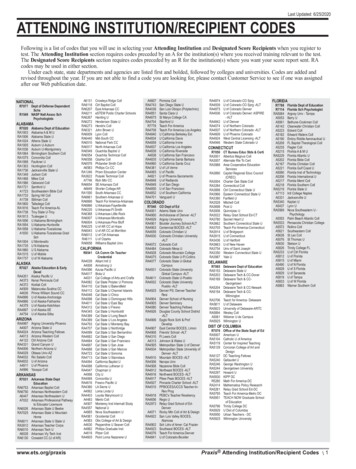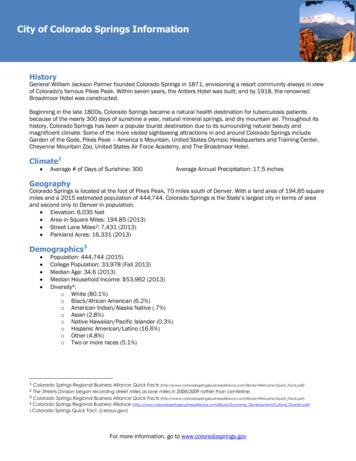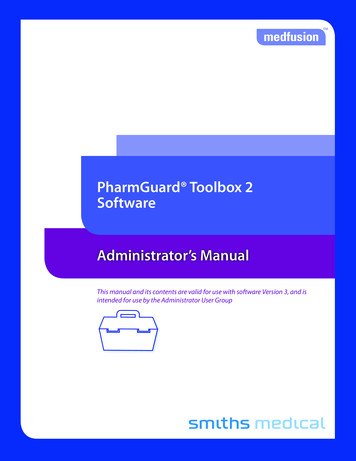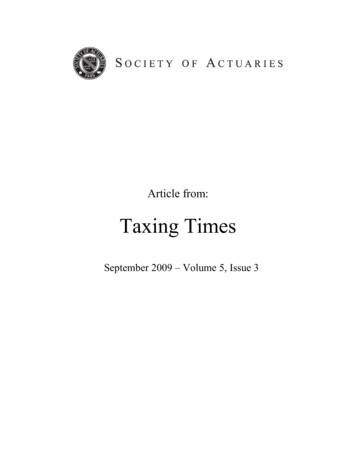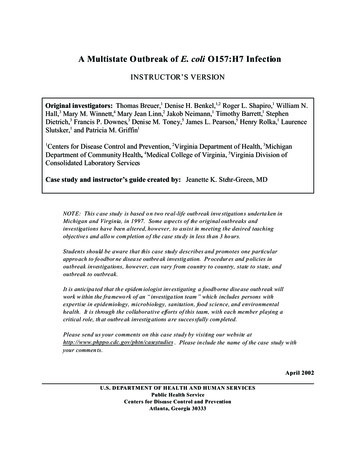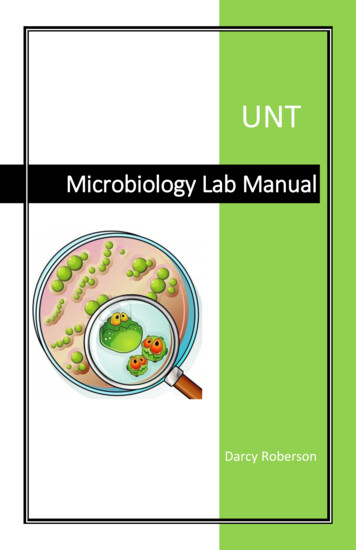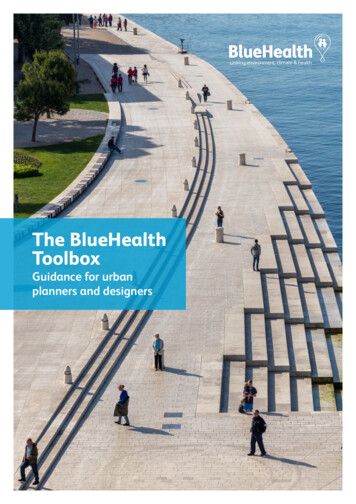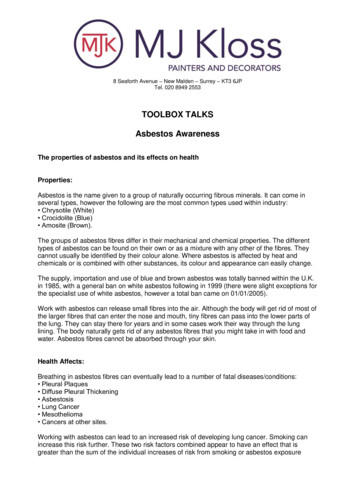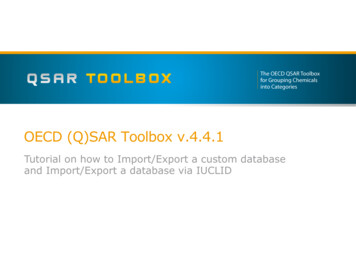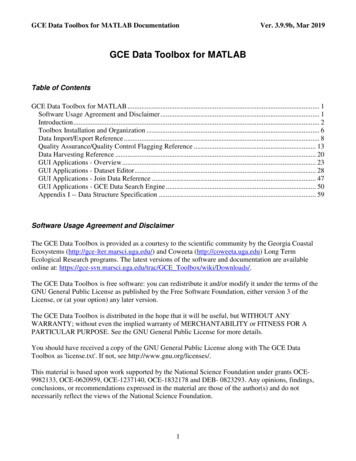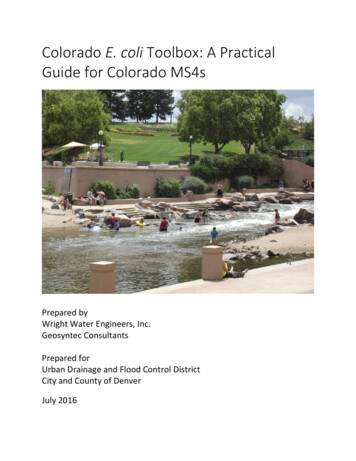
Transcription
Colorado E. coli Toolbox: A PracticalGuide for Colorado MS4sPrepared byWright Water Engineers, Inc.Geosyntec ConsultantsPrepared forUrban Drainage and Flood Control DistrictCity and County of DenverJuly 2016
AcknowledgementsThis report was prepared through the input of the following organizations and individuals:Wright Water Engineers, Inc.Jane ClaryAndrew Earles, P.E., Ph.D.Geosyntec ConsultantsBrandon Steets, P.E.Avery Blackwell, P.E.Jared Ervin, Ph.D.Adam Questad, P.E.Scott Struck, Ph.D.Urban Drainage and Flood Control DistrictHolly Piza, P.E.Ken MacKenzie, P.E.City and County of DenverSarah AndersonJon NovickDarren Mollendor, P.E.ReviewersLisa Knerr, Colorado Department of Public Health and EnvironmentJanice Lopitz, Keep It Clean PartnershipCandice Owen, City of BoulderCover Photo: Confluence Park in Denver, photo courtesy of Ken MacKenzie, Urban Drainage and FloodControl District.Material Adapted from Other Publications:Portions of Chapters 2, 4 and 5 were adapted directly from Pathogens in Urban Stormwater Systemsprepared by the Urban Water Resources Research Council of the Environmental and Water ResourcesInstitute of the American Society of Civil Engineers in 2014 with financial support from the UrbanDrainage and Flood Control District and the Urban Watersheds Research Institute. A complete copy ofthis 289-page report can be downloaded from http://collaborate.ewrinstitute.org/. Jane Clary, BrandonSteets, and Robert Pitt served as editors for the report.The intent of this Toolbox is to provide a concise, easy-to-read reference for use in urban areas inColorado. Thus, more detailed technical analysis supporting the condensed discussion in this Toolboxcan be obtained from the following sources for more detailed discussions, which provide the technicalunderpinnings of this Toolbox.Urban Water Resources Research Council of the Environmental and Water Resources Institute ofthe American Society of Civil Engineers. (2014). Pathogens in Urban Stormwater Systems.Eds. J. Clary, B. Steets, and R. Pitt. Prepared with support from the Urban Drainage andFlood Control District and the Urban Watersheds Research Institute. August.July 2016Colorado E. coli Toolboxii
Center for Watershed Protection and R. Pitt. (2004). Illicit Discharge Detection and Elimination: AGuidance Manual for Program Development and Technical Assessments. Center forWatershed Protection, Ellicott City, MD, and University of Alabama, Tuscaloosa, AL.http://www.cwp.org/online-watershed-library/cat ction-and-eliminationCity of Santa Barbara, Creeks Division, in Partnership with University of California, Santa Barbara.(2012). Tools for Tracking Human Fecal Pollution in Urban Storm Drains, Creeks, andBeaches. September 1, 2012. Accessible blobdload.aspx?BlobID 16722 blobdload.aspx?BlobID 16724Griffith, J.F., Layton, B.A., Boehm, A.B., Holden, P.A., Jay, J.A., Hagedorn, C., McGee, C.D., and S.B.Weisberg. (2013). The California Microbial Source Identification Manual: A Tiered Approachto Identifying Fecal Pollution Sources to Beaches. Technical Report 804 - December 2013.Prepared for the Southern California Coastal Water Research Project. Accessible at:http://www.waterboards.ca.gov/board info/agendas/2014/jan/012114 11 804 sipp mstmanual.pdfInternational Stormwater BMP Database, including various statistical summaries such as WrightWater Engineers and Geosyntec. (2010). International Stormwater Best ManagementPractices (BMP) Database Pollutant Category Summary: Fecal Indicator Bacteria, and 2014statistical appendices. Project sponsors include: Water Environment Research Foundation,Federal Highway Administration, American Society of Civil Engineers Environmental andWater Resources Institute, U.S. Environmental Protection Agency and American PublicWorks Association. Accessible at: www.bmpdatabase.orgU.S. Environmental Protection Agency. (2012). Recreational Water Quality Criteria. Office of uidance/standards/criteria/health/recreation/July 2016Colorado E. coli Toolboxiii
Acronyms and DUSDCMUVWHOWLAJuly 2016best management practice (also known as stormwater control practice)closed circuit televisionCenters for Disease ControlColorado Discharge Permit Systemcolony forming unitscombined sewer overflowColorado Water Quality Control CommissionColorado Water Quality Control Divisiondischarger specific varianceU.S. Environmental Protection Agencyfecal indicator bacteriageographic information systemillicit discharge detection and eliminationload allocationmonitoring and evaluationmaximum extent practicablemargin of safetymost probable numbermunicipal separate storm sewer systemmicrobial source trackingNational Epidemiological and Environmental Assessment of Recreational WaterNational Pollutant Discharge Elimination Systemnatural source exclusionNational Stormwater Quality Databaseprincipal component analysispolymerase chain reactionquantitative microbial risk assessmentwastewater treatment plantquantitative polymerase chain reactionRecreational Water Quality CriteriaSouthern California Coastal Water Research Projectstandard operating proceduresingle sample maximumsanitary sewer overflowstatistical threshold valuetolerable illness leveltotal maximum daily loaduse attainability analysisUrban Drainage and Flood Control DistrictUrban Storm Drainage and Flood Control ManualultravioletWorld Health Organizationwasteload allocationColorado E. coli Toolboxiv
TABLE OF CONTENTSExecutive Summary. 11Introduction . 51.1Purpose of this Toolbox . 51.2Colorado Recreational Water Quality Criteria and Recreational Use Impairment . 61.3Colorado’s Approach to E. coli TMDLs . 81.3.1TMDL Prioritization Process . 81.3.2Basic Components of a TMDL . 91.3.3Integration of Wasteload Allocations into Stormwater Permits . 111.3.4Alternatives to TMDLs . 121.42Finding the Source(s) of E. coli . 142.1Common Sources in Urban Areas . 142.2Prioritizing Sources for Investigation . 162.2.1General Considerations. 162.2.2San Diego County Example . 162.334Stakeholder Engagement . 13Source Identification Methods . 202.3.1Basic FIB Monitoring in Impaired Waters . 202.3.2Source Tracking Toolbox . 232.3.3Dry Weather Outfall Screening . 262.4Managing Data . 372.5Interpreting Data: Common Observations for Front Range E. coli Data. 38Developing a Control Strategy . 393.1Progression of Controls . 393.2Use of Models to Support BMP Implementation . 41Source Control BMPs . 444.1Education and Outreach . 464.2Repair of Aging Infrastructure and Correcting Illicit Connections . 464.3Maintenance of Storm Drains and Stormwater Controls . 484.4Street Sweeping . 484.5Downspout Disconnections and Site Designs Minimizing Directly Connected Impervious Area(Green Infrastructure Site Designs) . 494.6July 2016Pet Waste Disposal and Pet Control Ordinances . 50Colorado E. coli Toolboxv
54.7Animal Facilities Management. 504.8Bird Control . 514.9Urban Wildlife (Mammals). 544.10Irrigation, Car Washing and Power Washing . 554.11Good Housekeeping/Trash Management (Dumpsters, Restaurants, Garbage Cans) . 564.12Mobile Sources of Human Waste: Portable Toilets and RV Dumping . 574.13Septic Systems and Other Onsite Wastewater Treatment Systems . 584.14Homeless Encampment Outreach and Enforcement . 59Structural Control Practices . 605.1Passive Stormwater Structural BMPs. 605.1.1Urban Stormwater BMPs and Expected Effectiveness for Bacteria . 605.1.2BMP Performance Findings from the International Stormwater BMP Database . 645.1.3Optimizing BMP Designs to Enhance Bacteria Removal . 695.1.4Considerations for Evaluating Proprietary Devices . 725.2Low-Flow Diversions for Dry Weather Flows . 735.3Active Disinfection Practices for Wet and Dry Weather Flows. 755.4Considerations for Channel Designs . 776Public Health Advisories. 797Regulatory Considerations/Site-Specific Standards. 807.1Colorado’s Approach to Regulatory Alternatives for E. coli Standards . 807.2EPA’s Guide to Site-Specific Alternative Recreational Criteria under EPA’s 2012 RecreationalWater Quality Criteria . 817.2.1Epidemiological Studies . 827.2.2Quantitative Microbial Risk Assessment (QMRA) . 837.2.3Alternative Indicators or Methods . 868Conclusions . 879References . 88July 2016Colorado E. coli Toolboxvi
TablesTable 1. Recreational Water Quality Criteria for Colorado . 7Table 2. Potential Sources of FIB in Urbanized Areas and Adjoining Watersheds . 15Table 3. Factors Considered in a Source Prioritization Process . 18Table 4. Example Ranking of Weighted Scores for FIB Sources under Dry Weather Conditions Using SanDiego Spreadsheet Tool as Applied to the San Diego River. 19Table 5. Field and Analytical Parameters for Consideration in Basic FIB Sampling Programs. 22Table 6. Source Tracking Tools . 24Table 7. Example Tabulation of Results from Microbial Source Tracking Using a Toolbox Approach in SanDiego . 33Table 8. Sources and Strategies for Bacteria Reduction . 45Table 9. Summary of Selected Waterfowl Management Techniques . 52Table 10. Summary of Pigeon Control Measures . 53Table 11. Structural BMPs in USDCM Volume 3 . 61Table 12. International Stormwater BMP Database Performance Data for E. coli. 65Table 13. International Stormwater BMP Database Performance Data for Fecal Coliform . 66FiguresFigure 1. Example Load Duration Curve from South Platte River Segment 15 TMDL . 10Figure 2. Partners for Development of Effective E. coli Load Reduction Strategies . 13Figure 3. Six-Step Process of Microbial Source Identification . 20Figure 4. Flow Chart to Identify Most Likely Significant Flow Component Contributing to Elevated FIB . 29Figure 5. Use of Ammonia as a Tracer to Identify Drainage System Sections Contributing ContaminatedFlows . 30Figure 6. MS4 Microbial Source Identification Investigation Approach . 32Figure 7. Example Use of GIS in Microbial Source Tracking Studies . 34Figure 8. Balance of Priorities for Selection of Controls in Watersheds . 39Figure 9. Conceptual Cost-Benefit Curve and Managements Levels . 40Figure 10. Particle Sizes of Viruses, Bacteria and Protozoan Cysts. 63Figure 11. Boxplot Key . 64Figure 12. International Stormwater BMP Database Performance Data for E. coli . 65Figure 13. International Stormwater BMP Database Performance Data for Fecal Coliform. 66Figure 14. Presence/Absence of Discharge Plots for Bioretention Sites with Underdrains . 68Figure 15. Conceptual Subsurface Flow Wetlands . 72Figure 16. Public Health Signage . 79Figure 17. Example Recreational Advisory Messaging. 79Figure 18. QMRA Candidate Waterbodies . 83Figure 19. Overview of . 85July 2016Colorado E. coli Toolboxvii
This page intentionally blank.July 2016Colorado E. coli Toolboxviii
EXECUTIVE SUMMARYThe purpose of this Colorado E. coli Toolbox is to provide a consolidated resource to support localgovernments with Municipal Separate Storm Sewer System (MS4) permits working to reduce E. coliloading to impaired waterbodies in Colorado. As of 2016, approximately 70 stream segments inColorado are identified as impaired or in need of additional monitoring and evaluation due to elevatedE. coli concentrations relative to recreational water quality standards. This Toolbox provides a conciseoverview of regulations driving Total Maximum Daily Loads (TMDLs) and MS4 permit conditions andfocuses on approaches to understanding sources of E. coli, potential non-structural and structural bestmanagement practices (BMPs) to reduce E. coli loading, and regulatory alternatives.Pathogens (disease-causing organisms) are impractical to monitor directly, so fecal indicator bacteria(FIB) are used as a surrogate to indicate risk of gastrointestinal illness in place of direct measurement ofpathogens. Although there are a number of limitations with use of E. coli for this purpose, the U.S.Environmental Protection Agency (EPA 2012) concluded that E. coli (or enterococcus) were the bestcurrently available indicators appropriate for use in nationally-applicable recreational criteria. Whencommunicating with the public, it is often important to clarify that the fecal indicator bacteria called E.coli are not equivalent to the pathogenic strain of E. coli (O157:H7) that the public may be familiar withdue to highly publicized foodborne illness outbreaks.Most streams in Colorado’s urban areas are assigned “existing primary contact” recreation standards.Primary contact recreation is defined as “recreational activities where the ingestion of small quantitiesof water is likely to occur. Such activities include but are not limited to swimming, rafting, kayaking,tubing, windsurfing, water-skiing, and frequent water play by children” (WQCC 2012). Colorado’sprimary contact standard of 126 colony forming units per 100 milliliters (cfu/100 mL) for E. coli isexpressed as a not-to-be-exceeded geometric mean value, which is consistent with EPA’s 2012Recreational Water Quality Criteria and corresponds to an allowable swimmer illness rate of 36 illnessesper 1,000 exposures. Although a wide range of trends can occur for E. coli, a common trend in warmwater Colorado streams is elevated E. coli during the summer and/or early fall months and attainmentof the standard during the winter.As of early 2016, the Water Quality Control Division (Division) has finalized three E. coli TMDLs inColorado, including Segment 14 of the South Platte River, Boulder Creek Segment 2b, and Segment 15 ofthe South Platte River. Each of these TMDLs includes unique aspects, although basic requirements forEPA-approvable TMDLs are included in each. The Division has prioritized completion of additional E. coliTMDLs as a high priority on its near-term planning horizon.Sources of pathogens and FIB in MS4s and receiving waters vary widely, originating from both nonhuman and human sources. Representative sources of FIB in urbanized areas in Colorado may includeSSOs (sanitary sewer overflows), wet weather (stormwater) discharges from MS4s (which mobilize andconvey sources deposited on land surfaces), sewer leaks into and illicit connections to storm sewersystems (e.g., sanitary sewer connections to the storm sewer), illicit discharges to storm sewer systems(e.g., recreational vehicle dumping), failing or improperly located onsite wastewater treatment systems(septic systems), wastewater treatment plants (if not meeting discharge permit limits), urban wildlife,domestic pets, agriculture, and other sources. Allowed discharges to MS4s such as irrigation runoff anduncontaminated groundwater discharges may also transport FIB originating from other sources. It isbeneficial for MS4 permittees to have a broad understanding of the diverse sources of E. coli that mayJuly 2016Colorado E. coli Toolbox1
contribute to waterbody impairments; however, MS4 permittees are only responsible for controllingsources contributed through their MS4. In addition to fecal sources, non-fecal sources or reservoirs ofFIB exist. These include sediments in receiving waters, biofilms in storm sewers and waterbodysubstrate/sediments, and naturalized FIB associated within plants and soil. Although agriculturalsources are not the focus of this Toolbox, both livestock and manure management can be sources of FIBin watersheds where MS4 permittees are working toward watershed-scale solutions.Although some FIB sources can be controlled to an appreciable extent (e.g., wastewater discharges,sanitary sewer leaks, illicit connections), other sources are much more difficult to control. These diffuse,ubiquitous, and often mobile sources include anthropogenic (e.g., homeless populations) as well as nonanthropogenic sources such as wildlife (e.g., raccoons, beavers, and birds). Furthermore, not all sourcespresent the same public health threat; human fecal sources present a much higher illness risk than nonhuman and non-fecal sources. Properly accounting for and identifying potential sources in a particulararea is the first step in working toward minimizing FIB contributions from controllable sources andprotecting public health.Monitoring strategies to characterize local sources of FIB can range from simple and relativelyinexpensive sample collection and analysis of FIB and basic water quality parameters to higher costmicrobial source tracking (MST) approaches relying on advanced molecular methods. It isrecommended that entities with wasteload allocations in E. coli TMDLs begin with simple methods toidentify and prioritize anthropogenic FIB sources in their drainage areas and collection systems and thentarget source control strategies to address these. Monitoring and source tracking techniques selectedmay be limited by budget constraints, regulatory drivers, and available technical expertise. Althoughmonitoring and investigation can be costly, these costs are typically much less than the cost of structuralBMP implementation. It is typically worthwhile to invest in a well-designed monitoring program thatenables well-supported identification of sources to determine source controls and, where necessary,structural BMPs that effectively target highest priority (or highest risk) sources. This approach isexpected to provide the greatest likelihood of achieving meaningful contributions to public healthprotection and recreational beneficial use restoration.The foundation of E. coli load reduction plans is source controls, which are non-structural measures(behaviors) that help to reduce the E. coli sources and/or flow sources that are transporting E. coli to thestorm drainage systems. Effective implementation of source control practices typically involvescoordination with multiple local government departments, including sanitary sewer collection systemowners/operators. Interdepartmental and interjurisdictional coordination and collaboration areessential to achieving meaningful pathogen and FIB reduction.Structural stormwater control practices, referred to as permanent post-construction BMPs, are key toolsto help reduce E. coli loading in urban runoff. Options include flow-through and volume reductionbased treatment controls. Existing performance data indicate that passive (i.e., non-disinfection) flowthrough BMPs are unlikely to consistently achieve primary contact limits in treated effluent; therefore,volume reduction-based BMPs are the primary structural control strategy for achieving bacteria loadreductions. Green infrastructure approaches should be considered because they encourage infiltrationof stormwater and reduce dry weather flows. Flow-through treatment BMP types with performancedata indicating the potential ability to reduce E. coli concentrations include retention (wet) ponds,media filters, bioretention facilities and subsurface flow wetlands. Site-specific constraints, cost andsustainability (ability to maintain performance over time) will also affect selection of BMPs that aresuitable for any particular site. Active treatment, such as ultraviolet disinfection, and diversion of dry-July 2016Colorado E. coli Toolbox2
weather low flows to the sanitary sewer system are generally a last resort for controlling E. colidischarges to receiving waters, due to their high cost.In some urban areas across the United States, multi-million or billion dollar MS4 implementation planshave been developed to address FIB TMDLs; thus, substantial benefits may be gained by well-developedand clearly targeted special studies. For example, USEPA’s 2012 Recreational Water Quality Criteriarecognize the need for and allow the development of site-specific standards based on demonstrationthat local illness risks are low (due to the predominance of non-human sources). Meanwhile, MSTtechniques have become better validated, standardized, commercialized, and familiar/acceptable tostate and federal water quality regulators over the past few years. Therefore, states are becoming moreaccustomed and open to using MST and other tools like Quantitative Microbial Risk Assessment (QMRA)to modify TMDLs and water quality standards (or discharger-specific permit variances) after humansources are demonstrated to be absent or mostly absent.July 2016Colorado E. coli Toolbox3
This page intentionally left blank.July 2016Colorado E. coli Toolbox4
1 INTRODUCTION1.1 PURPOSE OF THIS TOOLBOXAs of 2016, approximately 70 stream segments in Colorado are identified as impaired or in need ofadditional monitoring and evaluation due to elevated E. coli concentrations relative to recreationalwater quality standards. For streams identified as impaired on Colorado’s “303(d) List,” typically thenext step is development of a total maximum daily load (TMDL), which determines the load reductionsneeded to attain recreational water quality standards. In urban areas, municipal separate storm sewersystems (MS4s) subject to Colorado Discharge Permit System (CDPS) permits may have additional permitrequirements to reduce E. coli loading as a result of these TMDLs.The purpose of this Toolbox is to provide a consolidated resource to support local governments withMS4s working to reduce E. coli loading to impaired waterbodies. Although the issue of E. coliimpairment in urban areas is complex, this Toolbox has been kept as simple as possible with theintention of providing readers with a broad range of backgrounds a resource to develop a generalunderstanding of the issues and to provide tools that may be useful for reducing E. coli loads from urbanareas. This Toolbox is organized into six chapters including: Introduction: this chapter provides a basic overview of recreational water quality criteria anduse impairment, Colorado’s approach to bacteria TMDLs, and suggestions for entities whoshould be at the table to work collaboratively towards solutions. Finding the Sources: the key to success in reducing E. coli loading to streams is understandingand identifying the sources of bacteria loading. This chapter provides an overview of sourceidentification techniques that a local government may want to consider to develop a betterunderstanding of sources. Developing a Control Strategy: controlling bacteria loads in urban areas can be both complexand expensive. This chapter provides general guidance on how to develop a control strategyprogressing from control of dry weather sources then wet weather sources, focusing first onhuman-related sources of bacteria loading. Source Control Practices: source control practices are the foundation of E. coli load reductionstrategies. This chapter provides a description of source control practices that communitiesshould consider for reducing E. coli loading. Structural Control Practices: structural control practices can reduce dry weather and wetweather loading to streams. Ideally, for dry weather
Aug 05, 2016 · The intent of this Toolbox is to provide a concise, easy-to-read reference for use in urban areas in Colorado. Thus, more detailed technical analysis supporting the condensed discussion in this Toolbox can be obtained from the following sources for more detailed discussions, which provide the
